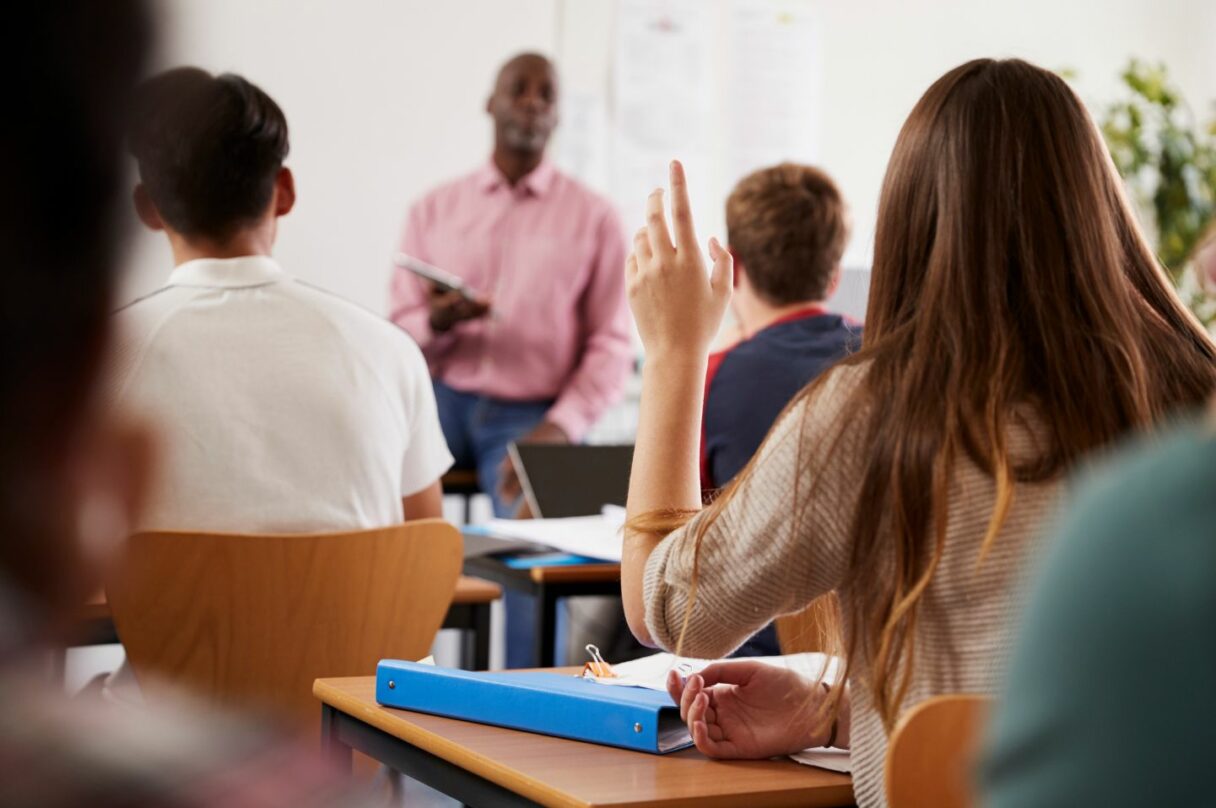1. Articulate clearly and confidently
Ensuring that your students understand the topic you are talking about is vital to making public speaking effective. Keeping the language used simple will make it easier for learners to understand the content.
Articulation transforms complex information into a clear and simple message, making it easy to process.
Unclear speech can impact a student’s understanding and reduce their engagement in the lesson. Difficulty in understanding the information being taught may lead to the student leaving the class without having learned anything or not understanding the correct context.
Shadowing an experienced public speaker will demonstrate what good public speaking should look like. Studying a stranger’s public speech will aid your interpretation of how to capture the audience’s attention, even if the audience is new.
You could also imitate or shadow someone you already look up to and observe what techniques they use to capture your own attention.
Listening to examples of effective sentence lengths provides good articulation. Having only one long sentence will lose learners’ attention, making it harder for them to stay focused. Instead, try breaking down the sentences into smaller ones.
Listening to monotone speakers can also be very exhausting and not very engaging at all that is why voice projection, sound, pace, and tone are so important when making a public speech in order to engage the listener.
2. Use powerful body language
Messages and communication can be transmitted through body language. Without even realizing it, our body conveys our emotions which can be read by other individuals; for example, if we are feeling nervous or anxious this can be identified by our body language, and the recipient can infer how you are feeling based on the body language being presented.

The first step to improving body language is to feel confident. Confidence is a trait that some more than others attain easier, but in essence, it means believing in yourself and your abilities.
When you feel confident, the public can see this in the way that your body is standing or is presented. Feel confident in your speech within the lesson you are teaching and most importantly feel confident that what you are teaching will be useful and effective for your students becomes they will feel eased and trust that you know the material you are presenting.
But how can we speak with confidence in public?
You can present yourself as a confident public speaker by preparing and organizing your teaching material before the presentation, whether that be ensuring you print off any material that is necessary for advance, creating cue cards to help you navigate your presentation or even arriving early for your speech.
Through various body language techniques, you can present yourself to your audience as a confident public speaker to control the space around you by using gestures to emphasize points, moving around slowly, and even using facial expressions to guide the sentiment and expression of your speech.
Showing negative facial expressions will impact the way you think. If the lesson is not going the way you had planned and you frown about it, your brain will receive a signal that the task is too difficult which will in turn cause an increase in stress level and will most likely make you slip up.
Additionally, maintaining eye contact with your students is a great way to connect and communicate with them about how they feel on the subject. Maintaining eye contact gives the invitation to turn to talk into a conversation and allows a teacher-student bond to be formed which will benefit both parties.
Although eye contact is important, thinking and maintaining eye contact at the same time has been evidently difficult to do. Our gut reaction when gathering our thoughts is to look away and then reconnect eye contact when thoughts have been collected. Instead of this, try to take a pause, think about the answer then when you are ready, answer the question.
Try focusing on taking a moment to breathe, smile and keep going.
3. Ehm… Eliminate filler words

Filler words do not add value, if anything, they can reduce fluidity. Commonly used words “like,” “well,” “so,” and “okay” are included in the filler words category. Other short examples include “um,” “er,” and “ah” which we use without realizing. Furthermore, phrases like “you know,” or “do you know what I mean?” count as filler words even though they do grammatically make sense.
In addition to body language showing how we feel, filler words can express anxiety that can be transmitted to students. These expressions, words, and phrases are used to create a pause in a speech to allow thought into what to say next. However, if used too many times, it can be misinterpreted and show that the speaker is nervous or anxious.
In some cases, however, filler words are used intentionally to fill gaps between thoughts or as a pause to rejuvenate the audience’s attention. Likewise, it is used to build emphasis on the next part of the presentation.
The temptation to use filler words is normal, although overusing them will create disfluency and the class will find it difficult to stay focused. Speech disfluencies will disengage students and distract them from their learning.
Eliminating filler words and simply replacing them with silence has a powerful effect. Silence is not necessarily a bad thing, in fact, small pauses of silence help students reflect on what you have said.
It produces a dramatic effect that allows the students to resonate and absorb any new information that they have learned. Silences do not have to be filled because they can have the powerful effect of producing moments of clarity or understanding.
4. Practice makes perfect
Practice makes perfect, right?
Preparing for public speaking is crucial when teaching. It grants room for improvement and secures that the lessons are provided in the right amount of detail; not too much to stray away from the topic and not too little where there is a gap in the learner’s understanding.
In terms of public speaking, practice is actively demonstrating a specific way of life. This is done by repeatedly doing the same action until you understand the task at hand completely.
The process of practicing will be beneficial as a teacher due to you familiarizing yourself with the content, words, and phrases from the presentation, allowing the speech to run smoothly.
Allow your friends to help you practice public speaking. Invite them out to have a coffee or in a quiet setting and have a casual conversation, applying the skills needed in public speech.
You could also ask them to listen to your lesson where they can ask you to challenge questions and help you practice how to respond. They can also provide feedback on what you are doing well and what you could do to improve.
When you are alone, you could record yourself, watch it back, and give yourself feedback on what went well and what you need to improve on. Make sure the audio has good quality as you want to be able to hear how you would sound to other people.
When listening to yourself back, think about whether you sound natural or if it sounds too rehearsed. Think about the tone and rhythm of your voice. Is it too slow or too fast? Remember it is okay to get it wrong on the first try. Keep practicing and you will improve.
5. Stay on topic, engage your audience

Speaking in front of a group can be scary which is why preparing is important. Staying on topic will endorse the students’ attention to be absorbed. Going in the wrong direction will make the information chaotic which will create confusion, leading to the learners not being interested.
A great way to stay on topic (which links to practice) is to write an outline of what you would like to discuss. Having knowledge on the topic will verbalize expertise and will make the topic easier to talk about. Then address the main points, following a further expansion of those points.
In addition, acknowledging the purpose of the lecture constructs an opportunity to be creative in the approach. How can you teach while making it interesting to your students? Understand whether you are informing your class or if you are creating a debate where you must persuade the other viewpoint.
Focus on presenting without any distractions. Turn off your TV and put your phone on Do Not Disturb. These factors will interfere with your thought process and unintentionally steer you in the wrong direction. Contrary to this, relax so you’re not too focused on being uncomfortable. It may also help your thought process if you are relaxed.
6. Ask questions, encourage interaction
Asking questions is an important part of learning. It demonstrates where the learner’s progress is and it enlarges what they already know. In addition, it takes the pressure off speaking to a group of people.
It develops a two-way conversation making the environment more relaxed. Asking for questions gives the students the chance to clarify any gaps in their learning. Also, it testifies how well they were paying attention. Asking questions during the lesson additionally shows if a student was paying attention or not. It gives an idea of the progress status.
The quality of questions will differ depending on the class. Younger students will ask simpler questions compared to an adult class. The questions and the amount you ask will also be dependent on what audience you are teaching. This will have to be taken into consideration when planning presentations.
When asking questions, let the class know when there will be an opportunity to do so. This could be as you go along pausing occasionally to answer questions or at the very end of the presentation.
Answering questions can be nerve-racking and could lead to an unsuitable response, whether it be over-sharing or something completely unnecessary. To avoid this from happening follow these steps:

- Listen to the question before answering. Questions do not need to be answered immediately due to a change in direction of the question. Give yourself a few seconds before answering;
- Understand what the question is about. If you do not have 100% clarity on the question, do not panic. You can ask the student to expand on the question to clarify what they mean before answering;
- Allow follow-up questions 1-1 when the class is doing a task. This will allow the students that are shyer to ask you a question. It will also just be a 1-1 conversation which relieves the pressure of answering in front of the whole group.
Conclusion
As we have demonstrated, public speaking is an important life skill but it is extremely useful for us teachers, who conducted lessons daily and want to engage our learners in the classroom.
Using these various tips and tricks will allow us to improve our public speaking and communication skills which will facilitate the formation of connections with students, and motivate positive change within our classrooms.
Although it may be nerve-wracking standing up in front of a class full of students if we articulate, use our body language effectively, reduce our filler words, stay on topic, ask questions, and most importantly practice, we will be one step closer to concretizing this useful life skill and creating an engaging educational sphere around us.
Erasmus courses on this topic:

